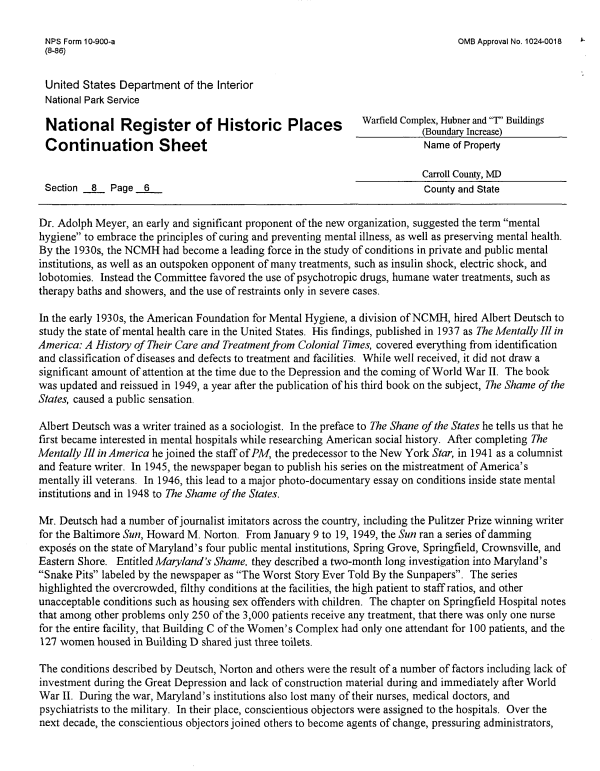 |
||||
|
DEPARTMENT OF HOUSING AND COMMUNITY DEVELOPMENT, MARYLAND HISTORICAL TRUST (Historic Sites Survey) var.d. MSA SE16-7 Image No: se16-7-0319 Enlarge and print image (85K) |
 |
||||
|
DEPARTMENT OF HOUSING AND COMMUNITY DEVELOPMENT, MARYLAND HISTORICAL TRUST (Historic Sites Survey) var.d. MSA SE16-7 Image No: se16-7-0319 Enlarge and print image (85K) |
| NFS Form 10-900-a OMB Approval No. 1024-0018 (8-86) United States Department of the Interior National Park Service National Register of Historic Places __________ Continuation Sheet Name of Property Carroll County, MD Section 8 Page _6_ County and State Dr. Adolph Meyer, an early and significant proponent of the new organization, suggested the term "mental hygiene" to embrace the principles of curing and preventing mental illness, as well as preserving mental health. By the 1930s, the NCMH had become a leading force in the study of conditions in private and public mental institutions, as well as an outspoken opponent of many treatments, such as insulin shock, electric shock, and lobotomies. Instead the Committee favored the use of psychotropic drugs, humane water treatments, such as therapy baths and showers, and the use of restraints only in severe cases. In the early 1930s, the American Foundation for Mental Hygiene, a division of NCMH, hired Albert Deutsch to study the state of mental health care in the United States. His findings, published in 1937 as The Mentally III in America: A History of Their Care and Treatment from Colonial Times, covered everything from identification and classification of diseases and defects to treatment and facilities. While well received, it did not draw a significant amount of attention at the time due to the Depression and the coming of World War II. The book was updated and reissued in 1949, a year after the publication of his third book on the subject, The Shame of the States, caused a public sensation. Albert Deutsch was a writer trained as a sociologist. In the preface to The Shane of the States he tells us that he first became interested in mental hospitals while researching American social history. After completing The Mentally III in America he joined the staff ofPM, the predecessor to the New York Star, in 1941 as a columnist and feature writer. In 1945, the newspaper began to publish his series on the mistreatment of America's mentally ill veterans. In 1946, this lead to a major photo-documentary essay on conditions inside state mental institutions and in 1948 to The Shame of the States. Mr. Deutsch had a number of journalist imitators across the country, including the Pulitzer Prize winning writer for the Baltimore Sun, Howard M. Norton. From January 9 to 19, 1949, the Sun ran a series of damming exposes on the state of Maryland's four public mental institutions, Spring Grove, Springfield, Crownsville, and Eastern Shore. Entitled Maryland's Shame, they described a two-month long investigation into Maryland's "Snake Pits" labeled by the newspaper as "The Worst Story Ever Told By the Sunpapers". The series highlighted the overcrowded, filthy conditions at the facilities, the high patient to staff ratios, and other unacceptable conditions such as housing sex offenders with children. The chapter on Springfield Hospital notes that among other problems only 250 of the 3,000 patients receive any treatment, that there was only one nurse for the entire facility, that Building C of the Women's Complex had only one attendant for 100 patients, and the 127 women housed in Building D shared just three toilets. The conditions described by Deutsch, Norton and others were the result of a number of factors including lack of investment during the Great Depression and lack of construction material during and immediately after World War II. During the war, Maryland's institutions also lost many of their nurses, medical doctors, and psychiatrists to the military. In their place, conscientious objectors were assigned to the hospitals. Over the next decade, the conscientious objectors joined others to become agents of change, pressuring administrators, |